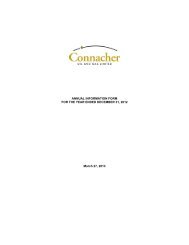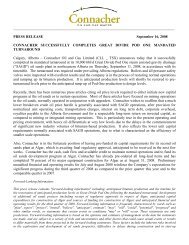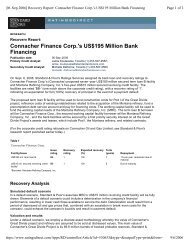ANNUAL REPORT 2011 - Connacher Oil and Gas
ANNUAL REPORT 2011 - Connacher Oil and Gas
ANNUAL REPORT 2011 - Connacher Oil and Gas
Create successful ePaper yourself
Turn your PDF publications into a flip-book with our unique Google optimized e-Paper software.
AR <strong>2011</strong><br />
PG 65<br />
Accounts receivable are due primarily from crude oil <strong>and</strong> natural gas purchasers in the petroleum <strong>and</strong> natural gas industry <strong>and</strong> Government <strong>and</strong><br />
large wholesale <strong>and</strong> retail purchasers of refined products. Accounts receivable are subject to normal industry credit risks. The company periodically<br />
assesses the financial strength of its purchasers <strong>and</strong> will adjust its marketing plan to mitigate credit risks. This assessment involves a review of<br />
external credit ratings <strong>and</strong> an internal credit review, based on the purchaser’s past financial performance. The company considers all amounts due over<br />
90 days as past due. As at December 31, <strong>2011</strong>, approximately $1.5 million (2010 : $1.1 million) of accounts receivable were past due primarily from<br />
taxation authorities, all of which were considered to be collectible.<br />
The company is also exposed to credit risk from counterparties to risk management contracts. This risk is managed by limiting counterparties to<br />
investment grade banking institutions; there has been no history of impairment with these counterparties.<br />
The maximum exposure to credit risk relating to the above classes of financial assets at December 31, <strong>2011</strong> <strong>and</strong> 2010 is the carrying amount of<br />
these assets.<br />
Liquidity risk<br />
Liquidity risk is the risk that the company will not have sufficient funds to repay its debts <strong>and</strong> fulfill its financial obligations. To manage this risk,<br />
the company pre–funds major development projects, monitors expenditures against pre–approved budgets to control costs, regularly monitors its<br />
operating cash flow, working capital <strong>and</strong> bank balances against its business plan, maintains accessible revolving banking lines of credit <strong>and</strong> maintains<br />
prudent insurance programs to minimize exposure to insurable losses. Additionally, the long term nature of the company’s debt repayment obligations<br />
is aligned to the long term nature of its assets. Principal repayments are not required on the Second Lien Senior Notes until their maturity in 2018 <strong>and</strong><br />
2019. The company also has a revolving credit facility of $100 million (note 13.4), which gives <strong>Connacher</strong> additional short–term financial flexibility for<br />
its working capital requirements. The following table shows the maturities of <strong>Connacher</strong>’s financial liabilities:<br />
As at December 31, <strong>2011</strong><br />
Total Within 1 year 2–5 years 6–7 years<br />
(Canadian dollar in thous<strong>and</strong>s)<br />
Non–derivative liabilities:<br />
Accounts payable <strong>and</strong> accrued liabilities $ 126,367 $ 126,367 $ – $ –<br />
Long–term debt <strong>and</strong> interest payment obligations (1) 1,556,982 180,559 312,679 1,063,744<br />
Derivative–based liabilities:<br />
Risk management contracts $ 7,610 $ 7,610 $ – $ –<br />
(1) USD denominated principal <strong>and</strong> interested payments are converted into Canadian dollars using exchange rate prevailing on December 31, <strong>2011</strong>.<br />
Market risk <strong>and</strong> sensitivity analysis<br />
Market risk is the risk that the fair value or future cash flows of a financial instrument will fluctuate because of changes in market prices. The objective<br />
of market risk management is to manage <strong>and</strong> control market price exposures within acceptable limits, while maximizing returns. Market risk is<br />
comprised of commodity price risk, interest rate risk <strong>and</strong> foreign currency risk.<br />
Commodity price risk<br />
The company is exposed to commodity price risk as a result of potential changes in the market prices of its bitumen <strong>and</strong> refined product sales <strong>and</strong><br />
its crude oil <strong>and</strong> natural gas sales <strong>and</strong> purchases. In accordance with policies approved by the Board of Directors, derivative contracts, including<br />
commodity futures contracts, price swaps <strong>and</strong> collars may be utilized to reduce exposure to price fluctuations associated with a portion of these sales<br />
or purchases. The following table summarizes the net position of the company’s risk management contracts:<br />
As at December 31<br />
<strong>2011</strong> 2010<br />
(Canadian dollar in thous<strong>and</strong>s)<br />
Current liabilities (assets)<br />
Crude oil contracts $ 11,001 $ 8,241<br />
Refined products contracts (5,593) –<br />
Natural gas contracts 2,202 743<br />
Current liabilities 7,610 8,984<br />
Non–current liabilities<br />
Crude oil contracts – 9,879<br />
Non–current liabilities – 9,879<br />
Risk management contract liabilities $ 7,610 $ 18,863












